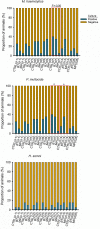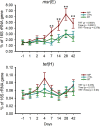A Single Intranasal Dose of Bacterial Therapeutics to Calves Confers Longitudinal Modulation of the Nasopharyngeal Microbiota: a Pilot Study
- PMID: 36971568
- PMCID: PMC10134831
- DOI: 10.1128/msystems.01016-22
A Single Intranasal Dose of Bacterial Therapeutics to Calves Confers Longitudinal Modulation of the Nasopharyngeal Microbiota: a Pilot Study
Abstract
To address the emergence of antimicrobial-resistant pathogens in livestock, microbiome-based strategies are increasingly being sought to reduce antimicrobial use. Here, we describe the effects of intranasal application of bacterial therapeutics (BTs) on the bovine respiratory microbiota and used structural equation modeling to investigate the causal networks after BT application. Beef cattle received (i) an intranasal cocktail of previously characterized BT strains, (ii) an injection of metaphylactic antimicrobial (tulathromycin), or (iii) intranasal saline. Despite being transient colonizers, inoculated BT strains induced longitudinal modulation of the nasopharyngeal bacterial microbiota while showing no adverse effect on animal health. The BT-mediated changes in bacteria included reduced diversity and richness and strengthened cooperative and competitive interactions. In contrast, tulathromycin increased bacterial diversity and antibiotic resistance and disrupted bacterial interactions. Overall, a single intranasal dose of BTs can modulate the bovine respiratory microbiota, highlighting that microbiome-based strategies have potential in being utilized to mitigate bovine respiratory disease in feedlot cattle. IMPORTANCE Bovine respiratory disease (BRD) remains the most significant health challenge affecting the North American beef cattle industry and results in $3 billion in economic losses yearly. Current BRD control strategies mainly rely on antibiotics, with metaphylaxis commonly employed to mitigate BRD incidence in commercial feedlots. However, the emergence of multidrug-resistant BRD pathogens threatens to reduce the efficacy of antimicrobials. Here, we investigated the potential use of novel bacterial therapeutics (BTs) to modulate the nasopharyngeal microbiota in beef calves, which are commonly administered metaphylactic antibiotics to mitigate BRD when sourced from auction markets. By direct comparison of the BTs with an antibiotic commonly used for BRD metaphylaxis in feedlots, this study conveyed the potential use of the BTs to modulate respiratory microbiome and thereby improve resistance against BRD in feedlot cattle.
Keywords: bacterial therapeutics; beef cattle; bovine respiratory pathogens; cattle; intranasal; microbial interactions; respiratory microbiota; structural equation modeling; tulathromycin.
Conflict of interest statement
The authors declare no conflict of interest.
Figures








Similar articles
-
Development of Bacterial Therapeutics against the Bovine Respiratory Pathogen Mannheimia haemolytica.Appl Environ Microbiol. 2019 Oct 16;85(21):e01359-19. doi: 10.1128/AEM.01359-19. Print 2019 Nov 1. Appl Environ Microbiol. 2019. PMID: 31444198 Free PMC article.
-
Intranasal Bacterial Therapeutics Reduce Colonization by the Respiratory Pathogen Mannheimia haemolytica in Dairy Calves.mSystems. 2020 Mar 3;5(2):e00629-19. doi: 10.1128/mSystems.00629-19. mSystems. 2020. PMID: 32127421 Free PMC article.
-
Injectable antimicrobials in commercial feedlot cattle and their effect on the nasopharyngeal microbiota and antimicrobial resistance.Vet Microbiol. 2018 Feb;214:140-147. doi: 10.1016/j.vetmic.2017.12.015. Epub 2017 Dec 22. Vet Microbiol. 2018. PMID: 29408026
-
Bovine respiratory microbiota of feedlot cattle and its association with disease.Vet Res. 2022 Jan 12;53(1):4. doi: 10.1186/s13567-021-01020-x. Vet Res. 2022. PMID: 35022062 Free PMC article. Review.
-
High-Risk Cattle Management and Stocker Calf Health: Modulation of the Bovine Respiratory Microbiome from a Systems Perspective.Vet Clin North Am Food Anim Pract. 2022 Jul;38(2):229-243. doi: 10.1016/j.cvfa.2022.03.001. Vet Clin North Am Food Anim Pract. 2022. PMID: 35691626 Review.
Cited by
-
Whole-body microbiota of newborn calves and their response to prenatal vitamin and mineral supplementation.Front Microbiol. 2023 Jun 26;14:1207601. doi: 10.3389/fmicb.2023.1207601. eCollection 2023. Front Microbiol. 2023. PMID: 37434710 Free PMC article.
-
A Scoping Review of Antimicrobial Usage and Antimicrobial Resistance in Beef Cow-Calf Herds in the United States and Canada.Antibiotics (Basel). 2023 Jul 12;12(7):1177. doi: 10.3390/antibiotics12071177. Antibiotics (Basel). 2023. PMID: 37508273 Free PMC article.
-
Stochasticity Highlights the Development of Both the Gastrointestinal and Upper-Respiratory-Tract Microbiomes of Neonatal Dairy Calves in Early Life.Animals (Basel). 2025 Jan 27;15(3):361. doi: 10.3390/ani15030361. Animals (Basel). 2025. PMID: 39943131 Free PMC article.
-
Auction market placement and a rest stop during transportation affect the respiratory bacterial microbiota of beef cattle.Front Microbiol. 2023 Sep 22;14:1192763. doi: 10.3389/fmicb.2023.1192763. eCollection 2023. Front Microbiol. 2023. PMID: 37808284 Free PMC article.
-
Effects of vaccination and interventions on nasal microbiome and BRD-associated pathogens in calves.Front Microbiol. 2024 Nov 18;15:1467908. doi: 10.3389/fmicb.2024.1467908. eCollection 2024. Front Microbiol. 2024. PMID: 39624725 Free PMC article.
References
Publication types
MeSH terms
Substances
LinkOut - more resources
Full Text Sources
